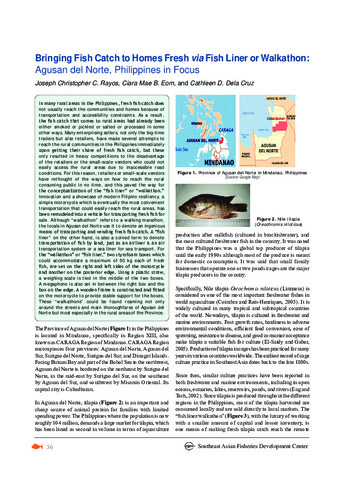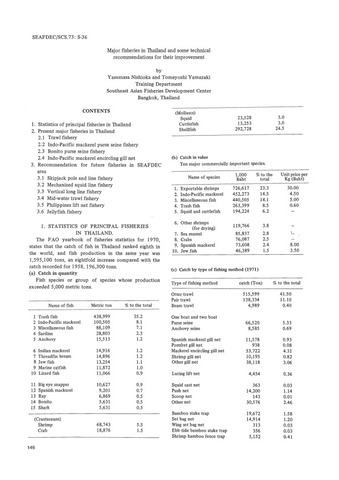Bringing fish catch to homes fresh via fish liner or walkathon: Agusan del Norte, Philippines in focus
Share
Abstract
In many rural areas in the Philippines, fresh fish catch does not usually reach the communities and homes because of transportation and accessibility constraints. As a result, the fish catch that comes to rural areas had already been either smoked or pickled or salted or processed in some other ways. Many enterprising sellers, not only the big-time traders but also retailers, have made several attempts to reach the rural communities in the Philippines immediately upon getting their share of fresh fish catch, but these only resulted in heavy competitions to the disadvantage of the retailers or the small-scale vendors who could not easily access the rural areas due to inaccessible road conditions. For this reason, retailers or small-scale vendors have rethought of the ways on how to reach the rural consuming public in no time, and this paved the way for the conceptualization of the “fish liner” or “walkathon.” Innovation and a showcase of modern Filipino resiliency, a simple motorcycle which is eventually the most convenient transportation that could easily reach the rural areas, has been remodeled into a vehicle for transporting fresh fish for sale. Although “walkathon” refers to a walking marathon, the locals in Agusan del Norte use it to denote an ingenious means of transporting and vending fresh fish catch. A “fish liner” on the other hand, is also a coined term to denote transportation of fish by land, just as an airliner is an air transportation system or a sea liner for sea transport. For the “walkathon” or “fish liner,” two styrofoam boxes which could accommodate a maximum of 50 kg each of fresh fish, are set on the right and left sides of the motorcycle and another on the posterior edge. Using a plastic straw, a weighing scale is tied in the middle of the two boxes. A megaphone is also set in between the right box and the box on the edge. A wooden frame is constructed and fitted on the motorcycle to provide stable support for the boxes. These “walkathons” could be found roaming not only around the streets and main thoroughfares of Agusan del Norte but most especially in the rural areas of the Province.
Suggested Citation
Rayos, J. C. C., Eom, C. M. B., & Dela Cruz, C. D. (2019). Bringing fish catch to homes fresh via fish liner or walkathon: Agusan del Norte, Philippines in focus. Fish for the People , 17(1), 36-38. http://hdl.handle.net/20.500.12066/4814
Subject
Collections
Related items
Showing items related by title, author, creator and subject.
-
Status of Fishing Conditions in Cambodia
Sour, Kim; Vuthy, Ros (Training Department, Southeast Asian Fisheries Development Center, 1997)Fisheries in plays a very important role in Cambodia’s national economic development. Total fish catch production in 1996 was 104 310 tones, about which 60% was contributed by inland capture fisheries, 30% by marine capture ... -
Major fisheries in Thailand and some technical recommendations for their improvement
Nishioka, Yasumasa; Yamazaki, Tomeyoshi (Japan International Cooperation Agency, 1977)Presented in this paper is the development of fisheries industry in Thailand. The data on the production of the principal fisheries species and major fishing methods are also presented. Also included are the recommendations ... -
The Status of Fisheries in the Republic of Maldives
Faiz, Mohamed (Training Department, Southeast Asian Fisheries Development Center, 1997)The paper discusses the tuna fisheries in Maldives which dominates its fishing industry. Apart from a very strong domestic market, tuna is also the main export commodity of the country. Moreover, reef fisheries such as, ...





